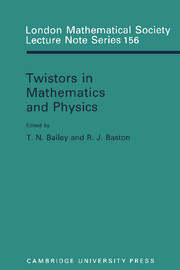Book contents
- Frontmatter
- Preface
- Contents
- 1 Twistor Theory After 25 Years—its Physical Status and Prospects
- 2 Between Integral Geometry and Twistors
- 3 Generalized Conformal Structures
- 4 Riemannian Twistor Spaces and Holonomy Groups
- 5 Twistors, Ambitwistors, and Conformal Gravity
- 6 The Penrose Transform
- 7 Notation for the Penrose Transform
- 8 The Twistor Transform
- 9 Invariant Operators
- 10 Penrose's Quasi-local Mass
- 11 The Sparling 3-form, Ashtekar Variables and Quasi-local Mass
- 12 Twistors and Strings
- 13 Integrable Systems in Twistor Theory
- 14 Twistor Characterization of Stationary Axisymmetric Solutions of Einstein's Equations
- 15 A Two-surface Encoding of Radiative Space-times
- 16 Twistors, Massless Fields and the Penrose Transform
- 17 Twistor Diagrams and Feynman Diagrams
- 18 Cohomology and Twistor Diagrams
- Authors' addresses
6 - The Penrose Transform
Published online by Cambridge University Press: 05 May 2013
- Frontmatter
- Preface
- Contents
- 1 Twistor Theory After 25 Years—its Physical Status and Prospects
- 2 Between Integral Geometry and Twistors
- 3 Generalized Conformal Structures
- 4 Riemannian Twistor Spaces and Holonomy Groups
- 5 Twistors, Ambitwistors, and Conformal Gravity
- 6 The Penrose Transform
- 7 Notation for the Penrose Transform
- 8 The Twistor Transform
- 9 Invariant Operators
- 10 Penrose's Quasi-local Mass
- 11 The Sparling 3-form, Ashtekar Variables and Quasi-local Mass
- 12 Twistors and Strings
- 13 Integrable Systems in Twistor Theory
- 14 Twistor Characterization of Stationary Axisymmetric Solutions of Einstein's Equations
- 15 A Two-surface Encoding of Radiative Space-times
- 16 Twistors, Massless Fields and the Penrose Transform
- 17 Twistor Diagrams and Feynman Diagrams
- 18 Cohomology and Twistor Diagrams
- Authors' addresses
Summary
Introduction
This article is a survey of developments in the Penrose transform since [8]. Recall that in [8] the transform was precisely the homomorphism
for
U = an open subset of M (= compactified complexified Minkowski space)
V = the corresponding open subset of P (= projective twistor space)
O(−n − 2) = the sheaf of germs of holomorphic functions homogeneous of degree −n − 2
Ƶn = the sheaf of germs of holomorphic solutions of the zero-rest-mass free field equations of helicity.
The transform was shown to be an isomorphism under mild topological conditions on U which hold, in particular, for the important special case of U = M+ and V = P+ (see [14] for standard twistor notation). Thus, one obtains a twistor description of positive frequency massless fields. The method of proof in [8] was to set up a general spectral sequence which specialized to give the different results for different values of n. In particular, one can see how the transform automatically falls into three cases:
Thus, one should view [8] as providing a cohomological ‘machine’ in the form of a spectral sequence which turns cohomology into differential equations.
- Type
- Chapter
- Information
- Twistors in Mathematics and Physics , pp. 87 - 103Publisher: Cambridge University PressPrint publication year: 1990
- 4
- Cited by

